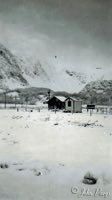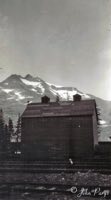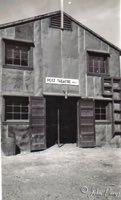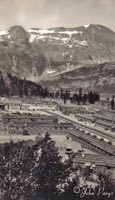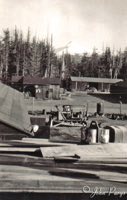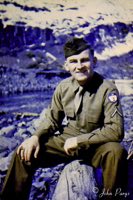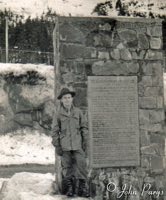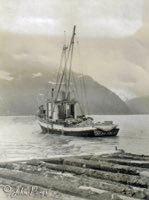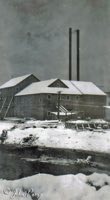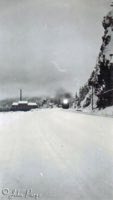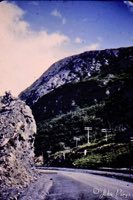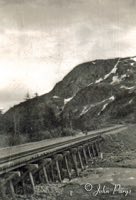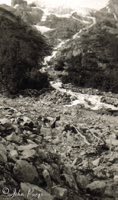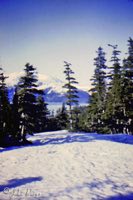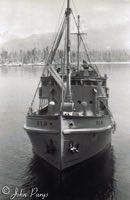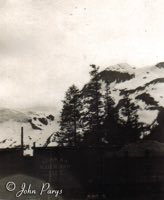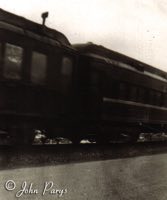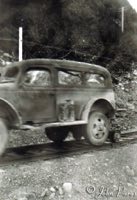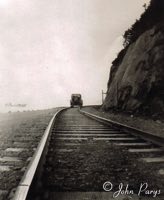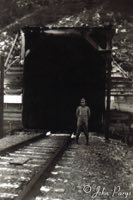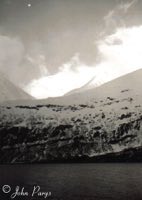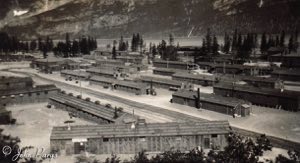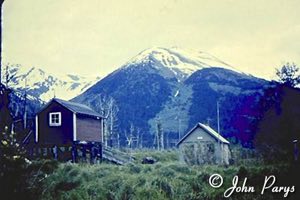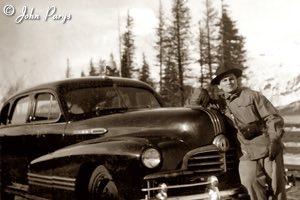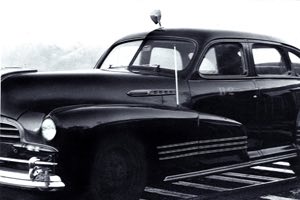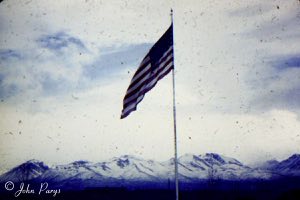 |
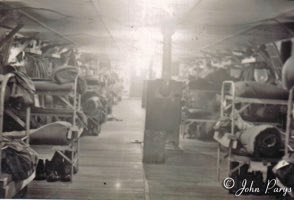 |
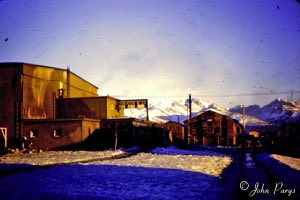 |
| 1. Flag Fort Richardson Cemetery |
2. Barracks |
3. Base Theater and barracks on Fort Richardson Army Airfield. |
|
 |
 |
| 4. Buildings at West Camp in Whittier near entry to tunnel |
5. Old Alaska Command HQ on then Fort Richardson Army Airfield, then Elmendorf Air Force Base and as of 2014 Joint Base Elmendorf Richardson |
6. Enlisted Mens or NCO Club at early Fort Richardson Army Airfield, later Elmendorf AFB. |
 |
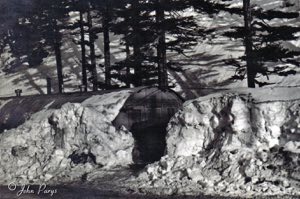 |
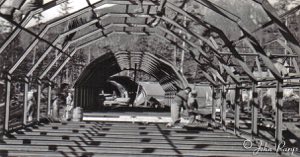 |
| 7. Typical barracks building in Whittier. There was no insulation. Just shiplap siding on 24" on center studs and tar paper on the outside. The barton strips were to keep the paper in place. Not much more on the roofs as they were build. Heat went right through the walls and roof resulting in lots of ice. |
8. Another Barracks under the snow to the right. Snow drifted to about 25 ft total. Had to use a dozer to clear.
There were lots of Quonset hut buildings. They did have a little insulation in some of the pre made panels. Snow commonly buried them and provided some insulation against the wind. |
9. Quonset huts were commonly ganged together with framed entries and junction points at the ends. |
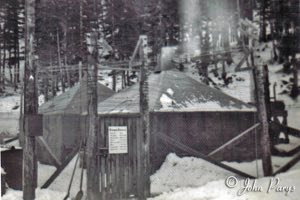 |
|
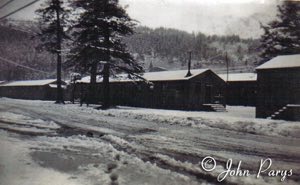 |
| 10. Whittier Guard House |
11. One of the first buildings in the Rail yard was this ICE HOUSE for storing ice to go on board railroad refrigerator cars or ships with perishables. Do not know if it had mechanical ice making equipment but it may have just stored blocks of lake ice shipped in on the ARR. |
12. Framed barracks located where the parade grounds and the Hodge building were eventually built in Whittier. |
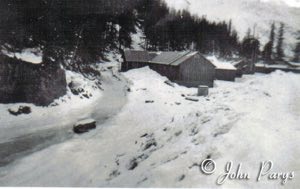 |
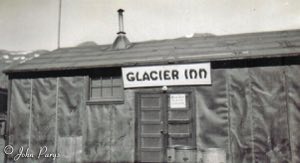 |
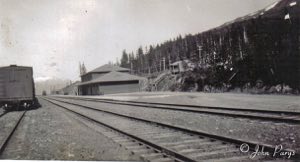 |
| 13. The Corp. of Engineers offices were some of the first built, just North of the Depot along a backwater at the base of the hill upon which the Buckner Building was later constructed in the early 50's. |
14. Guys call this the Wet PX |
15. The new Whittier Station before Whittier Arms Apartments were built on the hill to the right. The ARR dock is at the far end of the track past the Depot. |
|
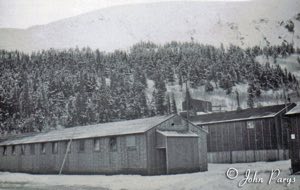 |
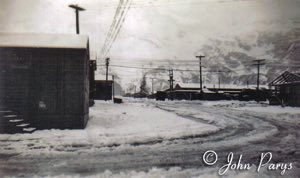 |
| 16. Post Theater; Interesting fire escape ladder. |
17. Building |
18. Building |
 |
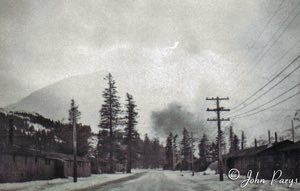 |
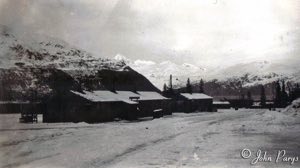 |
| 19. Building |
20. Building |
21. Our PX |
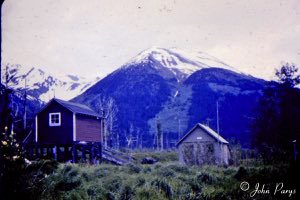 |
 |
 |
| 22. Forest Ranger's Cabin and Girdwood Railroad Station 1945 |
23. First permanent structure in Whittier was the two story ACS, Alaska Communications System, US Army Signal Corp. building. You could send a telegram or make a long distance call from there. The POST Censor listened in on your call and all mail coming and going was subject to censor here. This was a self contained secure facility and the Provost Marshals office was there. This is the only surviving building from this 1942-50 period. Today it has a third floor and is known as the Anchor Inn, bar and restaurant. |
24. Another view of Fort Richardson Army Airfield 1944-46 vintage. Today part of Joint Base Elmendorf Richardson. |
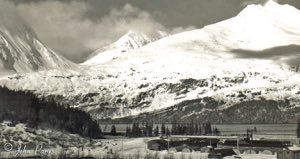 |
|
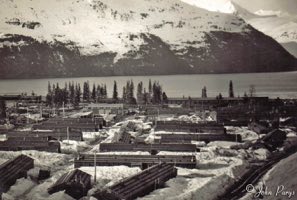 |
| 25. View North from where the Hodge building is today. Colombia Lumber Company slash burner is just left center and the sawmill is obscured by the trees. The row of Quonset huts by 1956 was being used as the Alaska Territorial School with about 200 students. |
26. No trace of these structures remain. At bottom right, the building with the large vents on the roof was the laundry. |
27. Combined with #25 this provides a panorama Whittier circa 1945. The tallest building in center is the ARR ice house and to the right is the long engine house. |
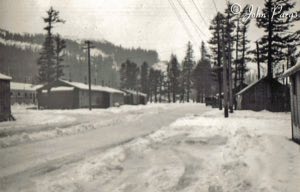 |
 |
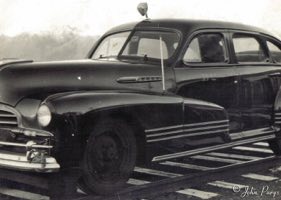 |
| 28. Building |
29. April or early May view after a hard winter. Similar view to #26. The rail yard is at the extreme right of this view. |
30. B-2 rail car |
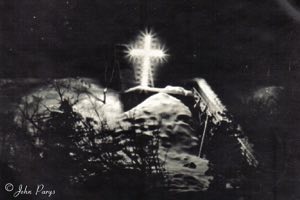 |
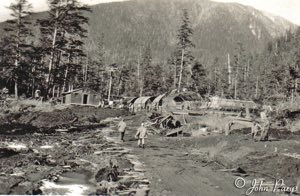 |
|
| 31. Christmas. Pipe to side of cross is Camp water supply line. |
32. This is another view of Quonset huts being built in image #9. This may be on the hill above camp where the road was built to the First Salmon Run. The original water mains and a hydro electric plant were supplied from that stream. Notice the corduroy road built on top of log slash from the Colombia Lumber mill. |
33. Creek |
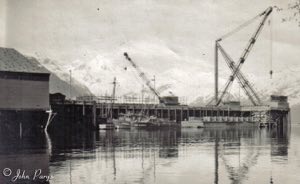 |
 |
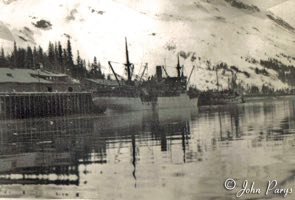 |
| 34. Old Reliable as we call the Dock. Taken from the Southern side. Army boat and Coast Guard boat tied in front. Large crane is called a stiff leg and has a capacity of 108 tons. |
35. Liberty ship. The opposite shore is about 2 miles away. Taken late afternoon at high tide. |
36. Dock and ship; Ocean side of the ARR Dock with a Liberty Ship at berth. Low tide and calm water with no wind. Dock was built in 1942 and destroyed by fire in 1952. |
 |
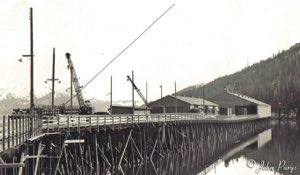 |
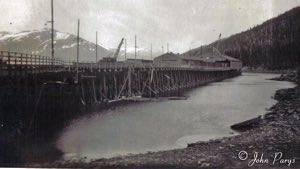 |
| 37. Dock, train and ship; Summer view of the ARR Whittier Dock . The Whittier Yard switcher #266 is moving a cut of empty box cars out on the Dock. Tide is low and the tug crew is setting on the rail maybe fishing. This is probably a civilian tug, the name Richard … is on the bow. |
38. Taken on a very calm day from across the bay. This is the dock where we work. |
39. Good contrast from photo 37, showing low tide from the land side of the ARR Dock. After this dock burned in 1952 it was replaced with several sections of war surplus Delong floating pier. These steel sections were jacked up on big steel pile and then secured in place. They survived the 64 earth quake and still provide the major public pier access for Whittier |
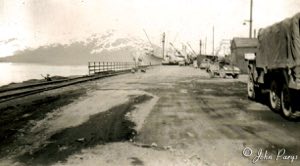 |
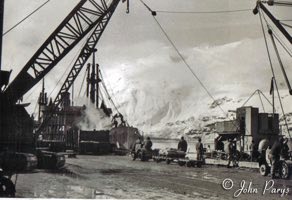 |
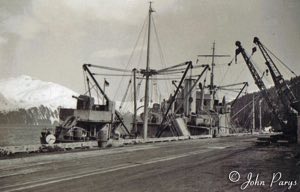 |
| 40. Land end of Whittier ARR dock. |
41. Busy scene on Whittier ARR Dock unloading two Liberty Ships. |
42. Whittier was a "SECRET" facility built just for the war. There were no civilian longshoremen. All work was done by the men of the Military Transport Service as it was known from 1944 until 1947. Other than the big ARR Stiff Leg crane, the cranes carried the logo of MTS an Army Transportation Corp. until |
 |
 |
 |
| 43. Late winter, early spring April or May view of the water front to be compared with late summer in view 45. |
44. Birds eve view of the ARR Railroad Dock in Whittier taken from the vantage of the hills behind the dock at Smitty Cove. |
45. Late summer August or September displaying the overhanging Whittier Glacier. The dock is at left on the water line. The ARR Depot is about center and the engine house and ice house are the large structures to the right. |
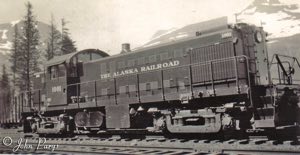 |
 |
|
| 46. Our daily train; Locomotives 1000 and 1001 were brand new Alco RS-1 units of 1000 hp. Purchased for the Alaska Railroad on a special war time authorization for use in and out of Whittier through the two long, unventilated tunnels on the way out to Portage and the ARR Main Line. |
47. No. 1001 |
48. A rudimentary gas station is shown here in the background. |
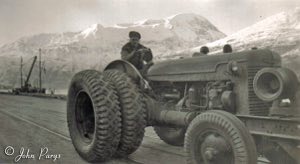 |
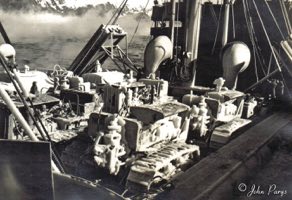 |
 |
| 49.Equipment |
50. CATS pretty well iced up; Deck loads crossing the North Pacific in the winter usually arrived with several inches of rime ice that had to be removed before unloading. Notice the fog in the background hanging over the water. These are certainly "cool cats" of the day. |
51. Girdwood Hotel 1945; Photo taken from the tracks looking at the back side of the Girdwood hotel. There was no highway connection until 1952. Girdwood served several gold mining operations up stream in Crow Creek Pass. Today Aleyeska Ski Resort and residential homes dominate the area served by the Seward Highway since 1952. |
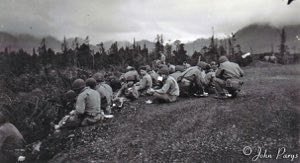 |
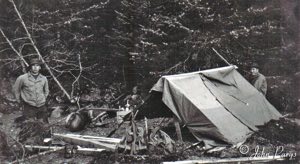 |
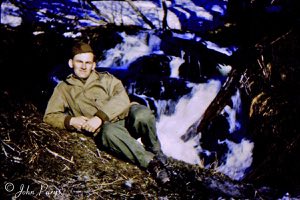 |
| 52. Having chow on hike |
53. GIs |
54. John Parys |
|
|
|
| 55. John Parys |
56. John Parys |
57. John Parys last day in Whittier waiting for the train. Many have stood next to this rock monument erected by the civilian contractors at the end of the depot platform. |
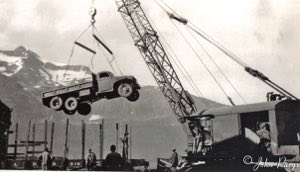 |
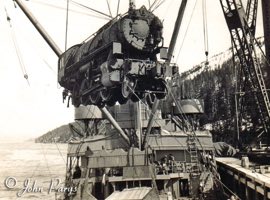 |
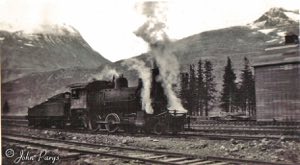 |
| 58. Hoisting 6x6 GM truck |
59. Unloading locomotive number 3521; This is the only photo showing an s-160 being unloaded in Whittier with the 100 ton stiff leg crane on the ARR Dock. There were no other facilities with rail access that could lift the load. The locomotive is standard issue G.I. s-160 with no electrical system, no power reverse. Until now there were no roster views of #558 so this fills a big void in the photographic record. Notice the guns were still in the gun tubs on this Victory Ship. |
60. Coal Burner; The Whittier Yard switcher #266 is one of the Panama Moguls shipped to the Alaska Engineering Commission in 1915 from the Panama Canal project. These machines were nearly 50 years old and bound for retirement as soon as the ARR got the 550 class engines in service. These were old D valve (slide valve) engines. This was probably a common parking area next toe the Ice House. |
|
 |
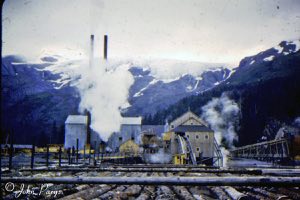 |
| 61.This is the boat that goes from the saw mill to the logging camp with food and supplies. Picture taken just before it left. You can see the supplies on the deck.; The TAKAN out of Juneau served Colombia Lumber Company taking supplies out to independent logging operations and towing back log rafts to feed the mill. |
62. Log raft, boat and GIs; The TAKAN out of Juneau served Colombia Lumber Company taking supplies out to independent logging operations and towing back log rafts to feed the mill. |
63. Columbia Lumber Company; Demand for lumber during the build up to WWII kept mills busy and Columbia Lumber was built as soon possible. This is the ocean side of the plant with the bull chain coming down into the water next to the little yellow boomers shack. The boilers burned much of the wood waste to supply all the mill needs for steam. The scrap went onto the conveyor at the right to feed the slash burner. |
|
|
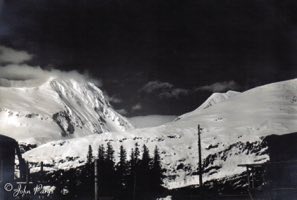 |
| 64. Columbia Lumber Company; The railroad side view of Columbia Lumber in the winter time was pretty quiet. In the summer this is where the sorting tables and crew labored to load flat cars with raw lumber. There was a planer mill for finished lumber. This facility survived until the 1964 earthquake when it was reduced to match sticks and concrete foundations. |
65. Mountains behind Whittier to the East in view from the beach road near Columbia Lumber. |
66. Maynard mountain is to the left here looking North West from Whittier. |
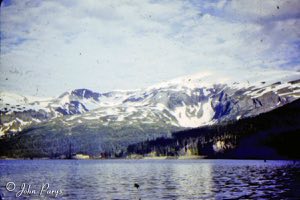 |
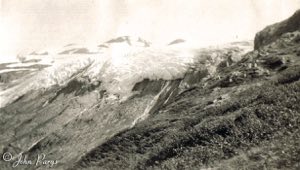 |
 |
| 67. Mid summer view across the water from West Camp. The stack and Colombia Lumber mill can be made out just left of center. Today that area is occupied by a large tour ship terminal. |
68. Summer view of the Whittier hanging glacier circa 1944-46 from the hill side West of Whittier. Most of this ice has retreated up and over the hill in the past 70 years. |
69. As you exit the Anton Anderson Tunnel arriving in Whittier the view up and to your left will reveal this pass filled with glacial ice. |
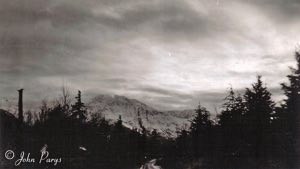 |
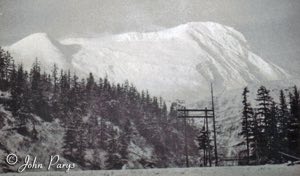 |
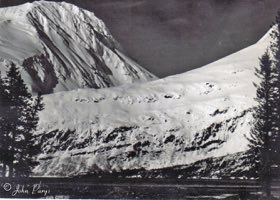 |
| 70. Mountains |
71. Closer view of Maynard Mountain. The character of the mountains changed dramatically with the seasons and snow cover. |
72. Closer view of Maynard Mountain. The character of the mountains changed dramatically with the seasons and snow cover. |
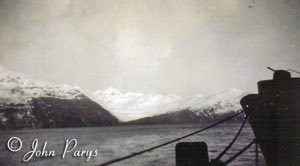 |
 |
|
| 73. Mountains |
74. Whittier can just be made out at the water line in this shot across the bay from West Camp, in those days the end of the road at the head of the bay. |
75. Train coming in; ARR Train departing Whittier bound for the tunnel passing Colombia Lumber. |
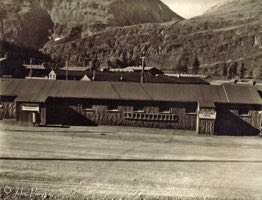 |
|
 |
| 76. Post exchange |
77. Rail cars |
78. From Tunnel looking toward Railroad station 1945; The road to West Camp just past Colombia Lumber. Portage Pass is out to the left over Portage Glacier and Lake. |
|
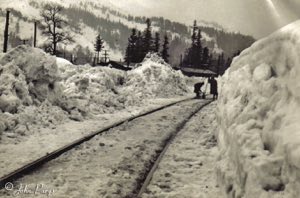 |
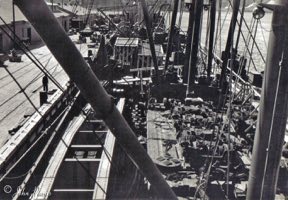 |
79. Rail crane; This is an Alaska Railroad Locomotive Crane parked with a small 4 wheel Plymouth or Whitcomb switcher. Notice the clam shell bucket setting to the left.
With no coaling facility, it was common practice to use the crane with clam shell to fuel the coal burning locomotives directly from a hopper or gondola loaded with coal. |
80. Across from our Barracks this Winter after the train pushes the snow away. |
81. Liberty ship came in with lots of railroad equipment. This is our line of work. Another one is tied up ahead. I cannot disclose the name of the ship. |
 |
 |
|
| 82. Camp; Summer looking West past the Corp of Engineers complex at the left. Compare the overhang of Whittier Glacier with modern photos. |
83. Portage at the Wye. The Water tank and a section gang shack made up the facility where the track branched off to go into Whittier. Temporary housing for the section crew was in old box cars set off along the track. |
84. Road from West Camp into Whittier just past the old "dump" Railroad is just to the right of the road. |
 |
|
|
| 85. Rail dock |
86. Rails |
87. Maynard Mountain in late summer. More important are the structures discovered here for the first time. At the left is a stiff leg crane with clam shell bucket that was used for coaling the steam engines. The tower would be the sanding tower to charge the sand boxes on the locomotives. To the right is the engine house. |
 |
 |
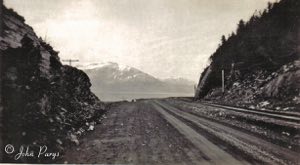 |
| 88. Early 1944-47 view of Whittier RR station taken from the ARR dock. Early winter view before the show was 10 ft deep on the rocks to the left where the Whittier Arms Apartments were later built. |
89. Yard view toward Maynard Mountain and Portage Pass to the left. Notice all wood box cars, very old stuff. By 1948 many of these would be replaced by war surplus rebuilt troop cars and kitchen cars made from steel. |
90. Another view of the road from West Camp just beyond the scene in photo 84. |
 |
|
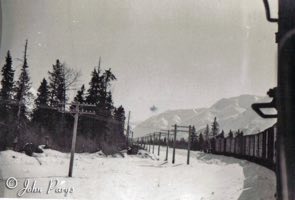 |
91. View of rail yard toward Portage Pass and Maynard Mountain in summer. At the left is the railroad engine house, Ice house and down on the point at Whittier Creek is Colombia Lumber.
Across the water at the head of the bay you can make out some white buildings at West Camp. West Camp provided housing, recreation and dinning services for the civilian construction gangs that were busy building Whittier. |
92. The combined railroad and road bridge across the creek coming out of Portage Pass at the head of the bay. Today, Just to the left here is a terminal building for several submarine fiber optic cables that connect to points as far south as Seattle. Just behind the photographer would be the present parking lot for the Whittier entrance to the Anton Anderson Tunnel for both highway and railroad vehicles. |
93. Bound for Portage and Anchorage after just exciting the short tunnel from Bear Valley. |
 |
 |
|
| 94. Taken from train going toward Whittier; Leaving Portage at the Wye headed up Portage Valley toward the glacier and the tunnels going into Whittier about 8 miles away. |
95. Rotary snow plow on a sunny spring day wind rowing snow out of the Whittier Yard. Cannot make out numbers on the equipment but that is probably steam Rotary #3 and it is being shoved along by one of the new S-160 550 class consolidations. |
96. Match this view up with #69 and you get an idea how far the glacier had receded. The Army built a large tank farm right at the bottom of this pass. My dad was the superintendent There in the late 50's. That jumble of rock made great homes for squirrels and whistlers. The "land fill" was not to far from there. As kids, we spent many hours with the 22 long rifle shooting rats for target practice. |
|
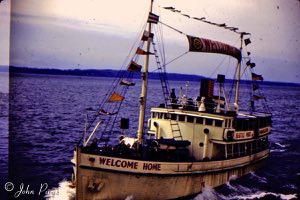 |
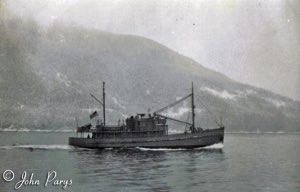 |
| 97. This snowbound trail is a summer road to the First Salmon Run. The road crests a hill just above the ARR dock site. |
98. Seattle Welcome Home |
99. "US Army coastal freighter" typed as an FS ship (Freight/Supply) during WWII in the bay at Whittier. Notice the gun mount on top of the pilot house. |
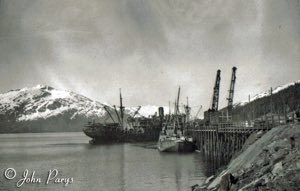 |
 |
|
| 100. Summer in Whittier and the Railroad dock is busy. Liberty ships lined up to get to a berth. Not hard to tell which ones are loaded. |
101. Ship dock |
102. FS-31 - FS stands for "Freight/Supply". The number 31 is simply the numerical order. They are small coastal freighters. FS-31 was delivered to the Army in 1943 by Petrich SB. She was built in Tacoma, Washington and was 114 ft in length. There were 318 of these ships built for the Army during the War. |
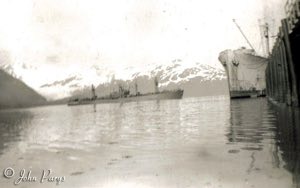 |
 |
 |
| 103. Summer in Whittier and the Railroad dock is busy. Liberty ships lined up to get to a berth. Not hard to tell which ones are loaded. |
104. Here is the Rotary plow again, still no number visible, parked next to the engine house. |
105. Looking East down 4th Avenue in Anchorage. The Club Bar on the left is still in the same location. The Federal building and the Post Office with the two large stacks, has been repurposed but remains a downtown fixture. The big department store of the time was the NC Co. behind the red sign on the right. Northern Commercial Co. was territorial wide. I believe 4th Avenue was the only paved street in 1944 and there were concrete sidewalks that dated back to 1916. |
|
|
 |
| 106. Train |
107. Train coming in |
108. Tender for locomotive #558 being unloaded in Whittier. |
|
|
|
| 109. The Army Signal Corp operated the Alaska Communications System and they had a number of these military rigs on permanent rail gear to patrol the miles of line alongside the ARR. Note these were not Hi/Rail machines they were stuck on the rails and could not go on the limited road network. |
110. The Army Signal Corp operated the Alaska Communications System and they had a number of these military rigs on permanent rail gear to patrol the miles of line alongside the ARR. Note these were not Hi/Rail machines they were stuck on the rails and could not go on the limited road network. |
111. This is the Whittier entry to the Alaska Railroad Tunnel. They had doors that needed to be opened for each train in the winter. They also had armed guard posts at each entry with telephone connection all during the war and for some time after. |
|
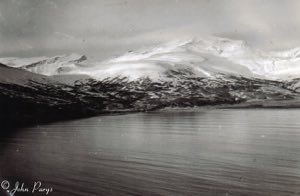 |
|
| 112. Water |
113. One of the many bays in Prince William Sound. Most like this one have a glacier at the headlands. This may be Blackstone Bay. Would welcome correction by a mariner. |
114. Waterfall |
|
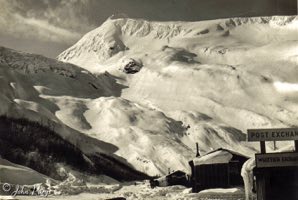 |
|
| 115. Very nice late summer view of the first generation of Army construction in Whittier. These buildings of shiplap and tar paper all made way for the later cold war "permanent" concrete structures. Only the street location remains the same today. There is no trace of any of the structures in this photo in 2015. |
116. Whittier post exchange; A beautiful sunny, windless, late winter day in Whittier probably 30° F. Looking up at the hanging glacier which today has receded almost out of sight over the summit. On these days, kids would strap on a pair of snowshoes and hit the slopes with the 410/22 over and under single shot. Ptarmigan (spruce hens) in winter white camo ranged these hills in large flocks. If you sat in one place with the 22 single shot and worked from the back of the flock, you could supply dinner for a family of 7, in short order. Of course you always had the 410 if they got to moving about. Great memories thanks to John Parys. |
117. Forest Ranger's Cabin and Girdwood station circa 1945 |
|
|
|
| 118. John Parys is reclining on Alaska Railroad autodialer #B2 circa 1944-46.
Notice the number on the door and the disc wheels which have a flange on the back side to keep it on the rails. It is captive on the rail and cannot get off the tracks like the modern Hy-Rail equipment. Does not appear to have a front license plate.
Tuns out it is a cheaper model of the Pontiac without all the chrome from 1941-1944 this model looked pretty much the same during the war. They sold a lot of them for military staff cars. Probably how it got to Alaska during the war. |
119. B2 |
|




